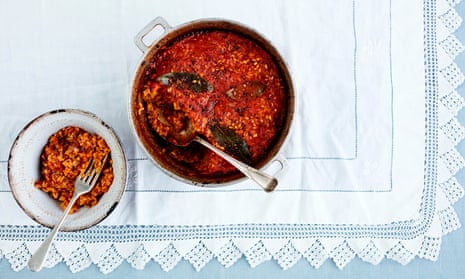Every August, we spend a couple of weeks on the wild south-west coast of Portugal. These holidays have a kind of ease that only comes from time spent in the same place: the comfort of repetition.
I have grown fond of Portuguese food. It is simple and homely, boldly flavoured and uncomplicated to execute. Like the long beaches of Portugal itself, we come back time and again to the same adored meals. Rustic bowls of caldo verde, a soulful soup of kale, potatoes, good olive oil and not much more, washed down with vinho verde, and custard tarts – which I buy stacked into cardboard tubes, complete with packets of icing sugar and cinnamon for sprinkling – to name two favourites.
Each year brings a new discovery, which we weave into the tapestry of our holiday eating. Last year, it was these moreish, pleasingly dense sweet potato cakes, called broas castelares, eaten for breakfast with a short, strong coffee. (I’ve made mine less sweet than the ones we were served in Portugal.) The year before, it was this tomato rice: sweet ripe tomatoes, saffron and pimentão (smoked paprika) baked into plump paella rice and eaten from cast-iron pots on plastic covered tables within the castle walls of old Faro. For me, holiday memories are all tastes ... and I’m eager for this year’s discovery.
Arroz de tomate (main picture)
You can skip blanching the tomatoes – I often do – but I’ve left it in for purists. You could use 50/50 passata and water here in place of the blitzed tomatoes, if you wanted to speed things up.
Serves 4-6
12 large, very ripe tomatoes
Olive oil
1 large onion, finely chopped
2 garlic cloves, finely chopped
A pinch of saffron
½ tsp sweet smoked paprika
A pinch of salt
1 tbsp tomato puree
1 fresh bay leaf, crumbled in your hand
350g paella rice
Black pepper
A small bunch of fresh parsley, leaves picked and finely chopped
1 If you’d like to blanch your tomatoes, fill a large bowl with iced water and boil the kettle. Slit a cross in the base of three of the tomatoes, put in another, heatproof bowl, pour over freshly boiled water and let them sit for 15 seconds, then drain and transfer the tomatoes to the iced water. Once they are totally cool, drain and peel the tomatoes, throwing away the skins.
2 Quarter the three tomatoes and cut out the seeds, then add the seeds to a blender. Dice the flesh, then set aside for later.
3 Slice the rest of the tomatoes in half and add to the blender along with their seeds. Blitz until you have a thin, smooth puree. Put a sieve over a large bowl and pour in the tomato puree, leaving it to sit while you get on with a few other things.
4 Put an ovenproof saucepan over a medium-low heat and add a little olive oil, then add the onion and garlic. Sweat for about 10 minutes, stirring occasionally, until the onion has become lightly golden. Preheat the oven to 190C/375F/gas 5.
5 Add the saffron to the onion and cook, stirring all the time, for 2 minutes. Then stir in the paprika, season and cook for another 2 minutes.
6 Next, add the diced tomato flesh and salt. Cook, stirring occasionally, until all the liquid from the tomatoes evaporates – about 3 minutes.
7 Add the tomato puree, bay leaf and enough oil to make the mixture sizzle. Cook, stirring gently, until the mixture looks concentrated – about 3 minutes. Remove the pan from the heat, scrape the mixture into a bowl and set aside.
8 Have a look at the blitzed tomatoes in the sieve. Push as much juice through as possible, leaving behind just the seeds, which you can discard. Measure the tomato juice into a jug – you need 1.2 litres in total. If you are a little short, make it up to this amount with some tap water.
9 Reheat the same pan in which the tomatoes were cooked, then add the rice and 1 tbsp of oil. Stir until the rice is toasted – about 2 minutes. Stir in the concentrated tomato mixture and spread the rice evenly in the pan.
10 Let it cook for 2 minutes, then gently stir in about 500ml of tomato water. Spread the rice in an even layer and adjust the heat to maintain a steady simmer. Cook, without stirring, for 5 minutes.
11 Gently pour in another 500ml of the tomato water and sprinkle over plenty of black pepper, scraping up any rice stuck to the bottom of the pan. Spread in an even layer and simmer until the rice is almost al dente – about 15 minutes. Don’t stir the rice, because it will release starch and make the dish gummy.
12 Pour the remaining 200ml tomato water into the pan, transfer to the oven and bake until the rice is al dente, a light brown crust has formed on the bottom, and the tomato liquid is creamy – about 15-20 minutes. Remove from the oven and let it rest for a few minutes. Discard the bay leaf. Serve with lots of chopped parsley.

Portuguese sweet potato cakes
Makes 8
400g sweet potatoes, roasted whole
150g golden caster sugar
2 eggs
2 tbsp runny honey
½ tsp fine salt
225g fine polenta or cornmeal
50g plain flour (I use spelt)
75g ground almonds
Zest of 1 orange
Zest of 1 lemon
2 tbsp icing sugar, for dusting
1 tsp cinnamon, for dusting
1 Preheat the oven to 220C/425F/gas 7. Roast the sweet potatoes whole until the flesh feels completely soft when you insert a knife into them. This may take anywhere between 45 and 90 minutes, depending on the size of your sweet potatoes.
2 Once the sweet potatoes are cooked, remove them from the oven (leave the oven on), slit them open with a sharp knife and scoop out all the pulp into a small saucepan. Discard the skins.
3 Add the sugar to the pan and cook on a low heat for 5 minutes, stirring all the time. This will allow some of the water to evaporate from the sweet potatoes, but be very careful, as the sugar will get extremely hot. Remove from the heat and allow to cool a little.
4 Crack the eggs into a little bowl, beat really well. Set aside 1 tbsp of the egg to glaze the cakes with later. Line a baking tray with greaseproof paper.
5 Combine eggs with the remaining ingredients (except those for dusting) in a large mixing bowl. Add the sweet potato mixture and beat really well, until you have a smooth and thick dough.
6 To shape the cakes, divide the dough roughly into eight pieces, roll each into a ball and then into a flat, oval-shaped cake. Put on the baking tray, brush with the remaining beaten egg and bake for 10-12 minutes, or until golden-brown.
7 When the cakes are baked, remove from the oven, and while the cakes are still hot dust with the icing sugar and cinnamon. Let the cakes cool completely on a wire rack before you eat them. They will keep for 48 hours in an airtight container.
Anna Jones is a chef, writer and author of A Modern Way to Eat and A Modern Way to Cook (Fourth Estate); annajones.co.uk; @we_are_food
- This article was corrected on 22 August 2017: we had used the Spanish name for the rice dish arroz con tomate, when it is in fact called arroz de tomate in Portuguese. The same goes for pimentão, which an earlier version had as pimentón.

Comments (…)
Sign in or create your Guardian account to join the discussion